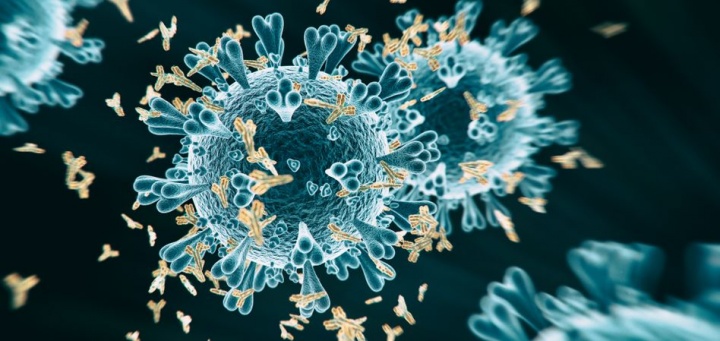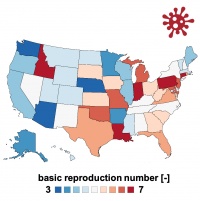(→matlab files) |
(→syllabus) |
||
| Line 110: | Line 110: | ||
! day !! date !! !! topic !! slides !! homework | ! day !! date !! !! topic !! slides !! homework | ||
|- | |- | ||
| − | | | + | | tue || jan || 06 || introduction to covid-19 || [http://biomechanics.stanford.edu/me334_16/me334_s01.pdf s01] || |
|- | |- | ||
| − | | | + | | thu || jan || 08 || I. infectious disesaes | a brief history || [http://biomechanics.stanford.edu/me334_16/me334_s02.pdf s02] || |
|- | |- | ||
| − | | | + | | tue || jan || 10 || II. mathematical epidemiology | 1. compartment modeling || [http://biomechanics.stanford.edu/me334_16/me334_s03.pdf s03]|| |
|- | |- | ||
| − | | | + | | thu || jan || 13 || brain anatomy - student presentations || [http://biomechanics.stanford.edu/me334_16/me334_s04.pdf s03]|| |
|- | |- | ||
| − | | | + | | tue || jan || 15 || brain anatomy - student presentations || [http://biomechanics.stanford.edu/me334_16/me334_s04.pdf s04] || |
|- | |- | ||
| − | | | + | | thu || jan || 22 || brain mechanics in 1d – elasticity of neurons || [http://biomechanics.stanford.edu/me334_16/me334_s05.pdf s05] || |
|- | |- | ||
| − | | | + | | tue || jan || 24 || brain mechanics in 3d – elasticity of the brain || [http://biomechanics.stanford.edu/me334_16/me334_s06.pdf s06] || |
|- | |- | ||
| − | | | + | | thu || jan || 27 || brain mechanics in 3d - probing the living brain || [http://biomechanics.stanford.edu/me334_16/me334_s07.pdf s07] || |
|- | |- | ||
| − | | | + | | tue || jan || 29 || brain growth in 1d – axonal growth || [http://biomechanics.stanford.edu/me334_16/me334_s08.pdf s08] || |
|- | |- | ||
| − | | | + | | thu || feb || 03 || brain growth in 2d – morphogenesis || [http://biomechanics.stanford.edu/me334_16/me334_s09.pdf s09] || |
|- | |- | ||
| − | | | + | | tue || feb || 05 || brain growth in 3d - physiology and pathologies || [http://biomechanics.stanford.edu/me334_16/me334_s10.pdf s10] || |
|- | |- | ||
| − | | | + | | thu || feb || 10 || brain damage in 1d – diffuse axonal injury || [http://biomechanics.stanford.edu/me334_16/me334_s11.pdf s11] || |
|- | |- | ||
| − | | | + | | tue || feb || 12 || brain damage in 3d – traumatic brain injury || [http://biomechanics.stanford.edu/me334_16/me334_s12.pdf s12] || |
|- | |- | ||
| − | | | + | | thu || feb || 19 || brain damage in 3d – neurodegeneration || [http://biomechanics.stanford.edu/me334_16/me334_s13.pdf s13] || |
|- | |- | ||
| − | | | + | | tue || feb || 21 || brain damage in 3d - brain atrophy || [http://biomechanics.stanford.edu/me334_16/me334_s14.pdf s14] || |
|- | |- | ||
| − | | | + | | thu || feb || 24 || brain surgery - brain doctors at john radcliffe || [http://biomechanics.stanford.edu/me334_16/me334_s15.pdf s15]|| |
|- | |- | ||
| − | | | + | | tue || feb || 26 || brain surgery - craniosynostosis || [http://biomechanics.stanford.edu/me334_16/me334_s16.pdf s16] || |
|- | |- | ||
| − | | | + | | thu || mar || 02 || brain surgery – decompressive craniectomy || [http://biomechanics.stanford.edu/me334_16/me334_s17.pdf s17] || |
|- | |- | ||
| − | | | + | | tue || mar || 04 || brain regeneration - spinal cord injury || [http://biomechanics.stanford.edu/me334_16/me334_s18.pdf s18] || |
|- | |- | ||
| − | | | + | | thu || mar || 09 || final projects - discussion, presentation, evaluation || [http://biomechanics.stanford.edu/me334_16/me334_s19.pdf s19] || |
|- | |- | ||
| − | | | + | | tue || mar || 11 || final projects - discussion, presentation, evaluation || [http://biomechanics.stanford.edu/me334_16/me334_s20.pdf s20] || |
|- | |- | ||
| − | | | + | | thu || mar || 13 || final project reports due || || |
|} | |} | ||
Revision as of 12:43, 20 August 2020
Contents |
fall 21 - me233 - data-driven modeling of covid-19
|
me 233 - data-driven modeling of covid-19 ellen kuhl
kevin linka fall 2021 |
me234 youtube channel
dissecting brains

| 
| 
| 
|

| 
| 
| 
|

| 
| 
| 
|

| 
| 
| 
|
objectives
understanding the outbreak dynamics of COVID-19 through the lens of mathematical models is an elusive but significant goal. within only half a year, the COVID-19 pandemic has resulted in more than 20 million reported cases across 188 countries with more than 700,000 deaths worldwide. this has generated an unprecedented volume of data; yet, the precise role of mathematical modeling in providing quantitative insight into the COVID-19 pandemic remains a topic of ongoing debate. this course discusses how to design computational tools to understand the COVID-19 outbreak. we focus on mathematical epidemiology, infectious disease models, concepts of the effective reproduction number and herd immunity, network modeling, outbreak dynamics and outbreak control, bayesian methods, model calibration and validation, prediction and uncertainty quantification. we highlight the early success of classical models for infectious diseases and show why these models fail to predict the current outbreak dynamics of COVID-19. we illustrate how data-driven modeling can integrate classical epidemiology modeling and machine learning to infer critical disease parameters—in real time—from reported case data to make informed predictions and guide political decision making. We critically discuss questions that current models can and cannot answer and showcase controversial decisions around the early outbreak dynamics, outbreak control, and exit strategies.
grading
- 15 % homework 01 - mathematical epidemiology of covid-19
- 15 % homework 02 - early outbreak dynamics of covid-19
- 15 % homework 03 - outbreak control of covid-19
- 25 % final project - presentation graded by class
- 30 % final project - report graded by instructors
previous class projects
harris tc, de rooij r, kuhl e.
the shrinking brain: cerebral atrophy following traumatic brain injury.
ann biomed eng. 2019; 47:1941-1959.
(download)
weickenmeier j, kurt m, ozkaya e, wintermark m, butts pauly k, kuhl e.
magnetic resonance elastography of the brain: a comparison between pigs and humans.
j mech beh biomed mat. 2018; 77:702-710.
(download)
wu lc, ye pp, kuo c, laksari k, camarillo d, kuhl e. pilot findings of brain displacements and deformations during roller coaster rides. j neurotrauma. 2017; 34:3198-3205. (download)
lejeune e, javili a, weickenmeier j, kuhl e, linder c. tri-layer wrinkling as a mechanism for anchoring center initiation in the developing cerebellum. soft matter. 2016;12:5613-5620. (download)
ploch cc, mansi cssa, jayamohan j, kuhl e. using 3D printing to create personalized brain models for neurosurgical training and preoperative planning. world neurosurg. 2016;90:668-674. (download), (perspectives)
syllabus
| day | date | topic | slides | homework | |
|---|---|---|---|---|---|
| tue | jan | 06 | introduction to covid-19 | s01 | |
| thu | jan | 08 | a brief history | s02 | |
| tue | jan | 10 | 1. compartment modeling | s03 | |
| thu | jan | 13 | brain anatomy - student presentations | s03 | |
| tue | jan | 15 | brain anatomy - student presentations | s04 | |
| thu | jan | 22 | brain mechanics in 1d – elasticity of neurons | s05 | |
| tue | jan | 24 | brain mechanics in 3d – elasticity of the brain | s06 | |
| thu | jan | 27 | brain mechanics in 3d - probing the living brain | s07 | |
| tue | jan | 29 | brain growth in 1d – axonal growth | s08 | |
| thu | feb | 03 | brain growth in 2d – morphogenesis | s09 | |
| tue | feb | 05 | brain growth in 3d - physiology and pathologies | s10 | |
| thu | feb | 10 | brain damage in 1d – diffuse axonal injury | s11 | |
| tue | feb | 12 | brain damage in 3d – traumatic brain injury | s12 | |
| thu | feb | 19 | brain damage in 3d – neurodegeneration | s13 | |
| tue | feb | 21 | brain damage in 3d - brain atrophy | s14 | |
| thu | feb | 24 | brain surgery - brain doctors at john radcliffe | s15 | |
| tue | feb | 26 | brain surgery - craniosynostosis | s16 | |
| thu | mar | 02 | brain surgery – decompressive craniectomy | s17 | |
| tue | mar | 04 | brain regeneration - spinal cord injury | s18 | |
| thu | mar | 09 | final projects - discussion, presentation, evaluation | s19 | |
| tue | mar | 11 | final projects - discussion, presentation, evaluation | s20 | |
| thu | mar | 13 | final project reports due |
python files
we'll share the python files for the projects here
additional reading
bayly pv, taber la, kroenke cd.
mechanical forces in cerebral cortical folding: a review of measurements and models.
j mech beh biomed mat. 2014;29:568-581.
(download)
budday s, steinmann p, kuhl e. the role of mechanics during brain development.
j mech phys solids. 2014:72:75-92.
(download)
budday s, nay r, steinmann p, wyrobek t, ovaert tc, kuhl e.
mechanical properties of gray and white matter brain tissue by indentation.
j mech behavior biomed mat. 2015;46:318-330.
(download)
budday s, steinmann p, kuhl e.
physical biology of human brain development.
front cell neurosci. 2015;9:257.
(download)
budday s, sommer g, birkl c, langkammer c, hayback j, kohnert j, bauer m, paulsen f, steinmann p, kuhl e, holzapfel ga. mechanical characterization of human brain tissue. acta biomat. 2017;48:319-340.
(download)
dennerll tj, lamoureux p, buxbaum re, heidemann sr.
the cytomechanics of axonal elongation and retraction.
j cell bio. 1989;109:3073-3083.
(download)
franceschini g, bigoni d, regitnig p, holzapfel ga.
brain tissue deforms similar to filled elastomers and follows consolidation theory.
j mech phys solids. 2006;54:2592-2620.
(download)
goriely a, geers mgd, holzapfel ga, jayamohan j, jerusalem a, sivaloganathan s, squier w, van dommelen jaw, waters s, kuhl e.
mechanics of the brain: perspectives, challenges, and opportunities.
biomech mod mechanobio. 2015;14:931-965.
(download)
hardan ay, libove ra, keshavan ms, melhem nm, minshew nj.
a preliminary longitudinal magnetic resonance imaging study of brain volume and cortical thickness in autism.
biol psych. 2009;66:320-326.
(download)
kruse sa, rose gh, glaser kj, manduca a, felmlee jp, jack cr, ehman rl.
magentic resonance elastography of the brain.
neuroimage. 2008;39:231-237.
(download)
miller k, chinzei k.
constitutive modelling of brain tissue: experiment and theory.
j biomech. 1997;30:1115-1121.
(download)
raybaud c, widjaja e.
development and dysgenesis of the cerebral cortex: malformations of cortical development.
neuroimag clin n am. 2011;21:483–543.
(download)
richman dp, stewart rm, hutchinson jw, caviness vs.
mechanical model of brain convolutional development.
science. 1975;189:18-21.
(download)
sun t, hevner rf.
growth and folding of the mammalian cerebral cortex: from molecules to malformations.
nature neurosci. 2014;15:217-231.
(download)
van essen dc.
a tension-based theory of morphogenesis and compact wiring in the central nervous system.
nature. 1997;385:313-318.
(download)
weickenmeier j, kuhl e, goriely a.
the multiphysics of prion-like disease: progression and atrophy.
phys rev lett. 2018;121:158101.
(download)



